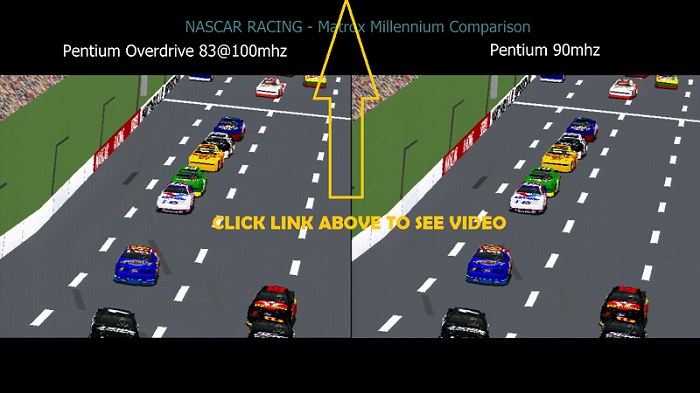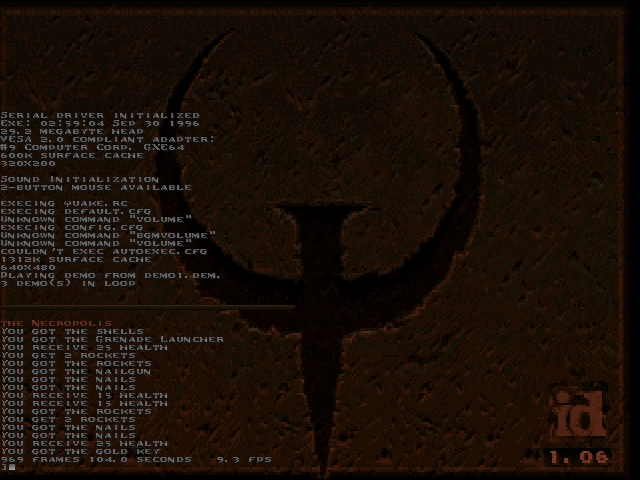First post, by vetz
- Rank
- l33t
I need your advice on a new video I'm working on. It will be the showdown of Creative 3D Blaster VLB vs Nvidia NV1 and Matrox Millennium in NASCAR Racing on period correct CPUs.
The main problem is that I've been screwed over on my PC Chips M921 486 PCI board (UMC 8881 chipset). I just discovered it has FAKE L2 cache! 😢
So not having L2 cache available on my 486 board makes a direct comparison with my 486 VLB board more difficult (Asus VL/I-486SV2(GX4) w/ 1MB L2 cache) as it can hurt performance. I was initially planning on testing the cards side by side on DX2 66mhz, DX4 100mhz, AMD X5 133mhz and the POD83@100mhz. After I figured out I had no L2 cache on the PCI board I've been rethinking this whole project as there is more issues than just missing L2 cache.
So I've been doing some tests and compared toFeipoa's Ultimate 486 benchmark comparison. What I've been trying to figure out is how much performance hit I'm suffering compared to having 256kb working L2 cache.
Tests were performed with the following system:
- Pentium Overdrive 83@100mhz
PC Chips M921 (DRAM 0/0, cache 2-1-2)
1x64MB FPM60NS RAM
Matrox Millennium 4MB + 2MB
Soundblaster AWE32 CT2760
Feipoa did previously not specify if config.sys/autoexec.bat are loaded for tests and if sound is enabled or not in Doom & Quake (EDIT: It is now clarified in the other thread, and sound were not enabled). To battle this I've included several tests of these two games.
Pentium Overdrive 83@100mhz with L1 WB - NO L2
- Speedsys: CPU: 73.76 - Memory bandwith: 121 MB/sec - L1 cache: 195 MB/sec - RAM throughput: 45.4 MB/sec - Video thoughput: 37 MB/sec (G200 = 44 MB/sec) - (Results are the same as in the benchmark comparison.)
- 3DBench - 1.0: 90.9 - 1.0c - 90.1 (99.9+ in 1.0 in 486 comparison)
- PCPBench - 8.7 (8.8 with boot directly into DOS with no config.sys and autoexec.bat) (9.4 in comparison)
- Quake no sound: 23.4 FPS (24.4 in 486 comparison)
- Quake w/sound: 22.2 FPS
- Doom (demo3) no config.sys & autoexec.bat: 50.6 FPS
- Doom (demo3) no sound: 48.8 FPS (53.4 in 486 comparison)
- Doom (demo3) w/sound: 46.4 FPS
AMD X5 133@160mhz L1 WB, NO L2 (not same amount of tests)
- Speedsys: Same as comparison
- PCPbench: 7.1 (7.7 in 486 comparison)
- Quake no sound: 16.4 FPS (17.3 in 486 comparison)
With the results from these two CPU's the results seems pretty evident that there is a 5-10% performance loss.
So how much faster is a Pentium 90 than my POD system?
Tested with system:
- Asus VX97 (Intel 430VX)
Pentium 90 (1.5x60)
2x32MB EDO RAM 60NS
Matrox Millennium 4MB + 2MB
Soundblaster AWE32 CT2760
Results:
- 3DBench - 1.0: 99.9+ - 1.0c - 94.4
- PCPBench - 14
- Quake no sound: 26.5 FPS
- Quake w/sound: 24.9 FPS
- Doom no sound: 51.3 FPS (demo3)
- Doom w/sound: 50 FPS (demo3)
The Pentium 90 is about 10-15% quicker compared to my POD system with no L2. If the POD had L2 cache it should be pretty much equal except for PCPBench which just runs ALOT quicker on the P90 if solely looking at these benchmarks.
You also have to consider that running the FSB at 40mhz on the 486 board puts a 2/3 divider on the PCI bus, slowing it down to 27 mhz (which also happened with feipoa). This means that the Matrox and NV1 will run at a slower bus speed than the VLB bus which runs at the overclocked 40mhz. The Pentium 90 runs at a 60mhz FSB, which gives 30 mhz PCI, so it isn't running at full speed either.
So what do you think? Should I run the PCI video cards with the 486 board without L2 cache and slower PCI bus? Or should I compare the 3D Blaster VLB (running with the POD 100mhz with L2 cache) directly against NV1 & Millennium on the Pentium 90? Remember that the Matrox and NV1 was designed for Socket 5 and 7 systems and not late 486 systems with PCI. There also seems to be something fishy going on as the difference between the two systems in NASCAR Racing is very noticable. Maybe L2 cache is really important in this game? If it only were 1-2 FPS like in Quake and Doom I would not have made this thread, but when I see NOTICABLE difference between the two systems in NASCAR Racing running on the Matrox Millennium I have to ask what I should feature in the video. Check for yourself in this short clip: http://youtu.be/wirXtDmkJzY

